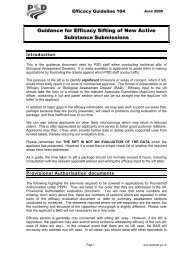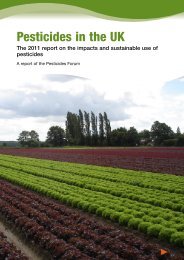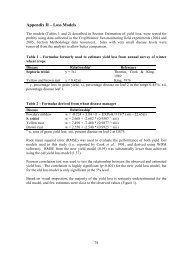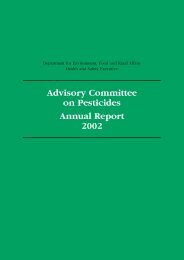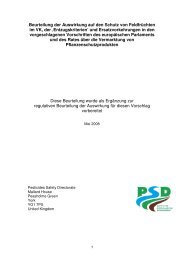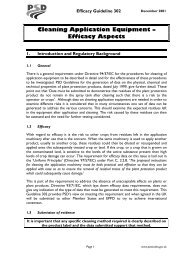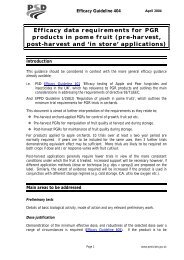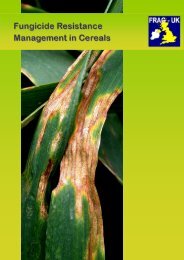Advisory Committee on Pesticides Annual Report 2001
ACP Annual Report 2001 - Pesticides Safety Directorate
ACP Annual Report 2001 - Pesticides Safety Directorate
Create successful ePaper yourself
Turn your PDF publications into a flip-book with our unique Google optimized e-Paper software.
<str<strong>on</strong>g>Advisory</str<strong>on</strong>g> <str<strong>on</strong>g>Committee</str<strong>on</strong>g> <strong>on</strong> <strong>Pesticides</strong> <strong>Annual</strong> <strong>Report</strong> <strong>2001</strong><br />
inhalati<strong>on</strong> was low, occurring in just 33 percent of samples, range 0.02 to 0.61<br />
mg/m 3 , median of n<strong>on</strong>-zero values, 0.12 mg/m 3 .<br />
Papers to address re-entry time policy for certain wood preservatives<br />
When a liquid wood preservative product is used indoors by a professi<strong>on</strong>al<br />
operator, there is a specified exclusi<strong>on</strong> period in which unprotected pers<strong>on</strong>s<br />
and animals should be kept away from the treated area. The time at which<br />
this exclusi<strong>on</strong> finishes is known as the ‘re-entry time’. Previously, there were<br />
two label phrases regarding re-entry time. These stipulated either a 48-hour<br />
or an eight-hour re-entry time, depending up<strong>on</strong> the product.<br />
80<br />
A 48-hour re-entry time was required unless data dem<strong>on</strong>strated that the<br />
exposure of people re-entering treated areas after eight hours was acceptable.<br />
The <str<strong>on</strong>g>Committee</str<strong>on</strong>g> c<strong>on</strong>sidered a review of the existing re-entry time policy, and<br />
the criteria used to identify appropriate re-entry times and rec<strong>on</strong>sidered<br />
whether shorter exclusi<strong>on</strong> periods might be acceptable for certain liquid wood<br />
preservatives. It compared the airborne c<strong>on</strong>centrati<strong>on</strong>s over time of the active<br />
substances, with appropriate NOAELs, and of any solvents in the product<br />
formulati<strong>on</strong>, with the occupati<strong>on</strong>al exposure standards (OES) or equivalent.<br />
The <str<strong>on</strong>g>Committee</str<strong>on</strong>g> agreed that the exposure of people to both the solvents and<br />
the active substances was c<strong>on</strong>sistently and acceptably low for a range of<br />
representative products.<br />
The <str<strong>on</strong>g>Committee</str<strong>on</strong>g> recognised that, historically, many products had c<strong>on</strong>tained<br />
volatile active substances and high c<strong>on</strong>centrati<strong>on</strong>s of solvents, and evaporati<strong>on</strong><br />
of surface residues had been significant. However, the products used in these<br />
areas had, over a number of years, been reformulated as water-based products<br />
c<strong>on</strong>taining involatile active substances and low c<strong>on</strong>centrati<strong>on</strong>s of solvents.<br />
As a c<strong>on</strong>sequence of this, the <str<strong>on</strong>g>Committee</str<strong>on</strong>g> agreed that there was no clear<br />
relati<strong>on</strong>ship between aerial c<strong>on</strong>centrati<strong>on</strong>s of the solvent or active substance<br />
and surface wetness of treated timber. Therefore, it agreed that exclusi<strong>on</strong> from<br />
the applicati<strong>on</strong> area should be c<strong>on</strong>sidered solely <strong>on</strong> the basis of the possibility<br />
of exposure to air c<strong>on</strong>centrati<strong>on</strong>s, with a physical barrier to prevent access to<br />
the treated timber until it was dry.<br />
The <str<strong>on</strong>g>Committee</str<strong>on</strong>g> c<strong>on</strong>sidered that it should be possible to allow certain liquid<br />
wood preservative products a <strong>on</strong>e-hour re-entry time. However, for this,<br />
the applicant would need to dem<strong>on</strong>strate c<strong>on</strong>vincingly that the aerial<br />
c<strong>on</strong>centrati<strong>on</strong>s of the active substance and solvent, for its individual products,<br />
were appropriately low within <strong>on</strong>e hour of applicati<strong>on</strong> at low levels of




